Technical paper/Expected loss
Using option prices to trade the underlying asset
The authors propose strategies with which to trade the underlying assets of options based on large data sets generated by options trading.
From incurred loss to current expected credit loss: a forensic analysis of the allowance for loan losses in unconditionally cancelable credit card portfolios
The authors analyze the performance of the CECL framework under plausible assumptions about allocations of future payments to existing credit card loans, a key implementation element.
A FAVAR modeling approach to credit risk stress testing and its application to the Hong Kong banking industry
In this paper, a credit risk stress testing model based on the factor-augmented vector autoregressive (FAVAR) approach is proposed to project credit risk loss under stressed scenarios.
IFRS 9 compliant economic adjustment of expected credit loss modeling
This paper presents an International Financial Reporting Standard 9 (IFRS 9) compliant solution related to expected credit loss modeling.
International Financial Reporting Standard 9 expected credit loss estimation: advanced models for estimating portfolio loss and weighting scenario losses
In this paper, the authors propose a model to estimate the expected portfolio losses brought about by recession risk and a quantitative approach to determine the scenario weights. The model and approach are validated by an empirical example, where they…
A triptych approach for reverse stress testing of complex portfolios
Pascal Traccucci et al present an extended reverse stress test triptych approach with three variables
International Financial Reporting Standard 9 expected credit loss estimation: advanced models for estimating portfolio loss and weighting scenario losses
In this paper, the authors propose a model to estimate the expected portfolio losses brought about by recession risk and a quantitative approach to determine the scenario weights.
Adapting the Basel II advanced internal-ratings-based models for International Financial Reporting Standard 9
This paper examines how we may use A-IRB models in the estimation of expected credit losses for IFRS 9 purposes.
Primary-firm-driven portfolio loss
This paper describes a simple model that can be used for risk management.
A prudent loss given default estimation for mortgages
The author of this paper proposes a prudent methodology to correct for potential biases in LGD estimations due to historical price appreciations, appraisal biases and wear-and-tear or potential damage to the house.
The simple link from default to LGD
The simple link from default to LGD
Understanding the expected loss debate
The final draft of the new global Accord on bank regulatory capital – Basel II – has been delayed. A critical and unresolved issue is whether banks should include expected losses in their measure of credit risk. The IMF's Paul Kupiec reports on efforts…
Unexpected recovery risk
For credit portfolio managers, the priority is to properly incorporate recovery rates into existingmodels. Here, Michael Pykhtin improves upon earlier approaches, allowing recovery rates todepend on the idiosyncratic part of a borrower's asset return, in…
Unexpected recovery risk
For credit portfolio managers, the priority is to properly incorporate recovery rates into existing models. Here, Michael Pykhtin improves upon earlier approaches, allowing recovery rates to depend on the idiosyncratic part of a borrower’s asset return,…
Credit risk measurement of securitisation structures
Peter-Paul Hoogbruin, Harmenjan Sijtsma and Viktor Tchistiakov of ING Group Credit Risk Management present a framework for valuing securitisation tranches from an investor’s perspective.
Calculating portfolio loss
For credit portfolios, analytical methods work best for tail risk, while Monte Carlo is used to model expected loss. However, products such as CDOs require a model for the entire distribution. Sandro Merino and Mark Nyfeler meet the challenge by…
Credit risk in asset securitisations: an analytical model
How much capital should banks reserve against investments in portfolio securitisations? Asserting that recent proposals on this subject by Basel are inconsistent, Michael Pykhtin and Ashish Dev propose a new analytical model suitable for tranches of…
Basel II - Rules and Models
The proposed operational risk charge remains one of the most contentious areas of the new Basel Accord. Carol Alexander reviews the current proposals in the context of various simple models, and argues that practical implementation will require the use…




